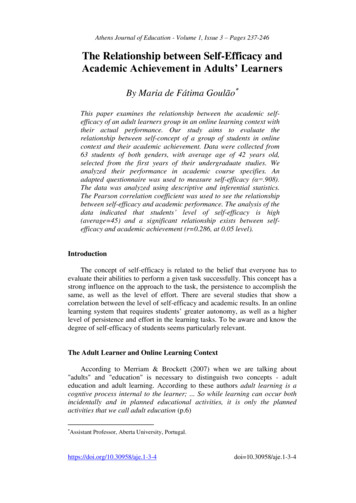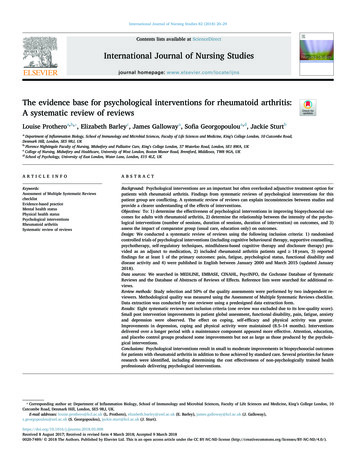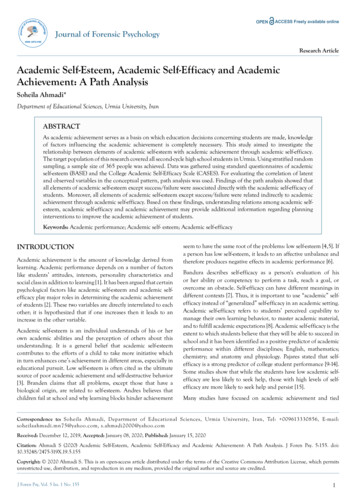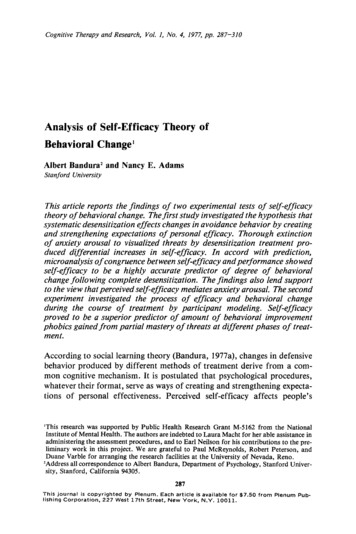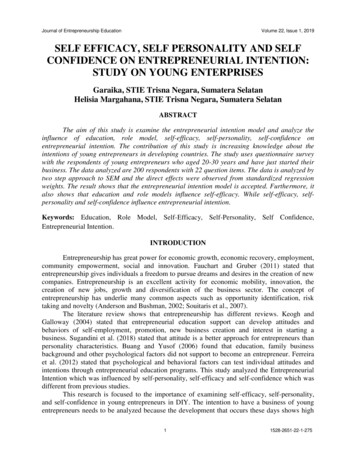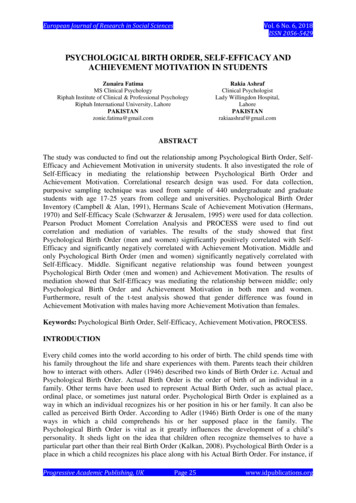
Transcription
European Journal of Research in Social SciencesVol. 6 No. 6, 2018ISSN 2056-5429PSYCHOLOGICAL BIRTH ORDER, SELF-EFFICACY ANDACHIEVEMENT MOTIVATION IN STUDENTSZunaira FatimaMS Clinical PsychologyRiphah Institute of Clinical & Professional PsychologyRiphah International University, LahorePAKISTANzonie.fatima@gmail.comRakia AshrafClinical PsychologistLady Willingdon CTThe study was conducted to find out the relationship among Psychological Birth Order, SelfEfficacy and Achievement Motivation in university students. It also investigated the role ofSelf-Efficacy in mediating the relationship between Psychological Birth Order andAchievement Motivation. Correlational research design was used. For data collection,purposive sampling technique was used from sample of 440 undergraduate and graduatestudents with age 17-25 years from college and universities. Psychological Birth OrderInventory (Campbell & Alan, 1991), Hermans Scale of Achievement Motivation (Hermans,1970) and Self-Efficacy Scale (Schwarzer & Jerusalem, 1995) were used for data collection.Pearson Product Moment Correlation Analysis and PROCESS were used to find outcorrelation and mediation of variables. The results of the study showed that firstPsychological Birth Order (men and women) significantly positively correlated with SelfEfficacy and significantly negatively correlated with Achievement Motivation. Middle andonly Psychological Birth Order (men and women) significantly negatively correlated withSelf-Efficacy. Middle. Significant negative relationship was found between youngestPsychological Birth Order (men and women) and Achievement Motivation. The results ofmediation showed that Self-Efficacy was mediating the relationship between middle; onlyPsychological Birth Order and Achievement Motivation in both men and women.Furthermore, result of the t-test analysis showed that gender difference was found inAchievement Motivation with males having more Achievement Motivation than females.Keywords: Psychological Birth Order, Self-Efficacy, Achievement Motivation, PROCESS.INTRODUCTIONEvery child comes into the world according to his order of birth. The child spends time withhis family throughout the life and share experiences with them. Parents teach their childrenhow to interact with others. Adler (1946) described two kinds of Birth Order i.e. Actual andPsychological Birth Order. Actual Birth Order is the order of birth of an individual in afamily. Other terms have been used to represent Actual Birth Order, such as actual place,ordinal place, or sometimes just natural order. Psychological Birth Order is explained as away in which an individual recognizes his or her position in his or her family. It can also becalled as perceived Birth Order. According to Adler (1946) Birth Order is one of the manyways in which a child comprehends his or her supposed place in the family. ThePsychological Birth Order is vital as it greatly influences the development of a child’spersonality. It sheds light on the idea that children often recognize themselves to have aparticular part other than their real Birth Order (Kalkan, 2008). Psychological Birth Order is aplace in which a child recognizes his place along with his Actual Birth Order. For instance, ifProgressive Academic Publishing, UKPage 25www.idpublications.org
European Journal of Research in Social SciencesVol. 6 No. 6, 2018ISSN 2056-5429the actual first born is incapable somehow, the second born may secure the role of the firstborn. Another example is that the adoptive child may have the first born but grown up as amiddle child position. The view that the biological impact of one’s birth when compared withthe environment in which one was born, had little influence (Adler, 1927). PsychologicalBirth Order was previously been categorized into five overall positions: first, second, middle,youngest, and only child (Adler, 1946; Ansbacher & Ansbacher, 1956). The PsychologicalBirth Order classified by Adlerian falls into four major positions: first, middle, youngest, andonly child. The second child position is not used in current Psychological Birth Orderbecause second child can be thought of as the younger of the two children in the family or asa middle child with a family of 3 or more children (Campbell, White & Stewart, 1991).The first born gets the limelight and care. First born are also under the strain to perform welland satisfy/meet their parent’s expectations and aspirations. Middle born may feel ordinary,neglected and unable to fit into their family. The middle born becomes the mediator andconflict resolver. Individuals who effectively overwhelmed these insights may appear withstrong social skills and an improved sense of self-worth (Adler, 1927). The youngest childremains the baby of the family forever. He is thought of someone as less capable and is oftendoted and spoiled. On the other hand, some individuals motivated in the youngest charactermay encounter prospects in their relations that put them into situations of significantimportance and regard. The only child, in some ways, has personality facets identical to thatof the first born e.g. highly accomplishing but have their own unique personalitycharacteristics. The only child tends to look collected and confident on the outside but deepdown, they are often insecure. On the other hand, those in the only child role as the result ofthe care and consideration of their parents could experience feelings of dependence orprivilege outside of their family (Adler, 1927).Bandura (1983) defined Self-Efficacy as the trust the individual has in his own abilities tohandle a situation effectively, to attain mastery in the coping skills he uses and finally to gainoutcome he desired. Self-Efficacy is not an attribute that is inherited rather it is a trait that isattained through learning. It is achieved at the time of birth and then is maintained till death.Self-Efficacy influences individual when they are reasoning and evaluating a situation andcompleting a task. Higher level of Self-Efficacy often is related with better performancebecause individuals who think that they can achieve a goal are expected to use necessaryeffort and continue against hardships. Self-Efficacy is generally explained as a trust of anindividual in his skills in achieving a target or an outcome (Luszczynska & Schwarzer, 2005).The evaluation of Self-Efficacy is influenced by environment and environmental responsesand these responses will determine the kind of adjustment that will happen due to SelfEfficacy. Evaluation of Self-Efficacy influences the individual’s behavior (Bandura, 1986).Achievement Motivation is explained as the individual’s struggle to accomplish his or heraims in public setting (Elliot & Church, 1997). Achievement Motivation is the want foraccomplishment, It is very significant element in goals determination especially when aperson realizes that his presentation will be assessed to standard of superiority (McClelland,1961). Achievement naturally pressures the importance of accomplishment in which effortinvolved in each skills and body of knowledge (Mandel & Marcus, 1988). Motivation can bedefined as an individual’s motive to engaging in different activity and the different steps towhich a person follows the action, and the determination of the person (Graham & Weiner,1996). According to Atkinson (1964) Achievement Motivation can be explained as contrastof performances with other performances and against usual activities. AchievementMotivation is a mixture of two personality variables the one is to reach Achievement and theProgressive Academic Publishing, UKPage 26www.idpublications.org
European Journal of Research in Social SciencesVol. 6 No. 6, 2018ISSN 2056-5429other is to evade disappointment. Achievement Motivation plays an important role inindividuals life. Motivated individuals achieve their goals easily. Motivation keeps people’sself-worth high. Individuals having high level of Achievement Motivation have desire towork on a problem and find its solution. Such individuals are more interested in theirpersonal accomplishments as compared to the prizes of Achievement (Singh, 2011).According to Social Cognitive Theory, three main factors affect Self-Efficacy. They allinfluence one another. Self-Efficacy emerging through mastery experiences in which aims arereached through determination and disabling problems and from noticing others prosperthrough continual struggle. High Self-Efficacy can influence Motivation in either good or badway. According to the theory, Self-Efficacy is one of the greatest significant factorsimpacting the academic performance and Achievement (Bandura, 1977).BehaviorPersonal FactorsEnvironmentalFactorsCognitive FactorsFigure 1 Social Cognitive Theory ModelLITERATURE REVIEWPrevious researches on Birth Order have been conducted with different variables (Tam & Ha,2011; Nash, 2009; Sharma & Maheshwari, 2013 ). Herndon (2012) conducted a study toinvestigate the association between the Adlerian lifestyle and Psychological Birth Orderconstructs by career decision Self-Efficacy. The sample of the study was 156 undergraduate’sstudents of southeastern university. Instruments used for data collection were the BASIS-AInventory, the PBOI and the CDSE Scale. Result of the study showed that the PsychologicalBirth Order factors had lesser substantial association with Career decision Self-Efficacy andother related features not establish important analytical ability with career decision SelfEfficacy. Draughn (2012) conducted a research to examine the directly Influence ofPsychological Birth Orders on student’s Achievement and Motivation. Psychological BirthOrder, Motivation and academic Achievement were measures through online survey.Samples of 183 students of public and private colleges were selected through criterionsampling technique. The study showed that Psychological Birth Order predicted scholarMotivation in search of seeking enjoyable and also predicted student Motivation in prizeseeking reaction.Davids (2015) research showed that significant association was found among Self-Efficacyand settings of ambition and Self-Efficacy and Attainment drive. 128 students were selectedfor the study. Three Questionnaires were used for data collection form the last year scholars.The conclusions of the study showed that significant association was found among SelfEfficacy and goal setting and Self-Efficacy and Attainment Motivation. Additionally, theProgressive Academic Publishing, UKPage 27www.idpublications.org
European Journal of Research in Social SciencesVol. 6 No. 6, 2018ISSN 2056-5429outcomes showed that Self-Efficacy and settings of ambition are important forecasters ofAchievement Motivation. Hussain (2014) study aims to determine gender differences andcorrelation in Self-Efficacy and academic Motivation. Through random sampling, 135participants from different business schools in Karachi were selected. The research wascarried out on the two Questionnaires of Self-Efficacy and Achievement Motivation . It wasconcluded that significant correlation was found in Self-Efficacy and Motivation. Result alsoindicated no gender difference in academic Motivation and Self-Efficacy. Akram andGhazanfar (2014) examine the association of Self-Efficacy and the academic presentation inrelations of CGPA of the scholars of Gujrat university. A sample of 193 students from 3rdsemester was selected through simple random sampling. The result showed that significantassociation among Self-Efficacy and Academic presentation of the scholars. Result alsoshowed difference in academic Self-Efficacy level with respect to gender. According toprevious researches Self-Efficacy and Achievement Motivation play a significant part ineducation.RationaleMany researches have been conducted on Actual Birth Order (Tam & Ha 2011; Nash, 2009 )but the phenomenon of Psychological Birth Order has never been investigated in pastregarding its role and influence on a person. Through current study, the effect ofPsychological Birth Order on Self-Efficacy and Achievement Motivation was determined.Psychological Birth Order and Self-Efficacy play significant role in students’ AchievementMotivation, so their Achievement Motivation can be enhanced in future by those factors indifferent settings for example home, school and training centers.Objectives The study will examine the relationship among Psychological Birth Order, SelfEfficacy and Achievement Motivation in students.The study will determine the role of Self-Efficacy in mediating the relationshipbetween Psychological Birth Order and Achievement Motivation.Hypotheses There is likely to be significant positive relationship among first Psychological BirthOrder (pleaser), Self-Efficacy and Achievement Motivation.There is likely to be significant negative relationship among middle PsychologicalBirth Order (neglected), Self-Efficacy and Achievement Motivation.There is likely to be significant positive relationship among youngest PsychologicalBirth Order (initiator), Self-Efficacy and Achievement Motivation.There is likely to be significant negative relationship among only Psychological BirthOrder (scrutinized), Self-Efficacy and Achievement Motivation.Self-Efficacy is likely to mediate the relation between Psychological Birth Order andAchievement Motivation.Progressive Academic Publishing, UKPage 28www.idpublications.org
European Journal of Research in Social SciencesVol. 6 No. 6, 2018ISSN 2056-5429Proposed ModelSelf-EfficacyFirst Psychological Birth OrderAchievement MotivationMiddle Psychological Birth OrderYoungest Psychological Birth OrderOnly Psychological Birth OrderFigure 2 showing proposed Model of Mediation AnalysisMETHODOLOGYResearch Design: Correlational research design was used in the study.Sample: Sample contained 220 males and 220 females students from different universitiesand colleges of Lahore.Sampling Technique: The purposive sampling technique was used.Operational DefinitionsPsychological Birth OrderPsychological Birth Order is explained according to Birth Order in which one character isthoroughly classified, regardless of one’s natural place (Campbell & Stewart, 1991).Self-EfficacySelf-Efficacy can be defined as faith in one’s capability to respond to and controlenvironmental difficulties and challenges (Schwarzer, 1992).Progressive Academic Publishing, UKPage 29www.idpublications.org
European Journal of Research in Social SciencesVol. 6 No. 6, 2018ISSN 2056-5429Achievement MotivationAchievement Motivation ascribes to expectation and sometimes ascribes to a stimulus forhold and high level of performance and Motivation to Achieve something (Hermans, 1970).MeasuresDemographic Information SheetIt included the information related to age, gender, Birth Order, family system and othervariables encompassing detailed information about participants.Psychological Birth Order Inventory (White & Campbell, 1991)Psychological Birth Order Inventory was used that measured one’s Psychological BirthOrder. This inventory has different no of items. The instrument has 46 questions with eitherYes or No in responses.Self-Efficacy Scale (Schwarzer, 1995)Self-Efficacy Scale was used for data collection. Self-efficacy scale has 10 items. The scalewas arranged to measure a person’s supposed Self-Efficacy as well as his capability tomanage everyday difficulties, although evaluating his capability to accustom after a worryinglife incident happened.Achievement Motivation Scale (Hermans, 1970)It is a self-report Achievement Motivation Questionnaire. The instrument has 29 items withmultiple options. Achieving high scores in this scale would indicate having highAchievement Motivation.ProcedureStudy was start after getting topic approved from synopsis Department Board of AdvanceStudies and Research (BASAR). Permission of the measuring instruments using in the studywas taken from authors to use Scale. Permission was sought from the heads of differentuniversities and colleges. Each participant was provided detailed information sheet regardingthe research to guide them about research proposal. Participants also provided Consent formto make sure that they are willingly to participate in the study. They were informed aboutethical considerations and their rights. After that pilot a main study was conducted, and datawas collected from different colleges and universities students through demographic sheetand questionnaires.Progressive Academic Publishing, UKPage 30www.idpublications.org
European Journal of Research in Social SciencesVol. 6 No. 6, 2018ISSN 2056-5429RESULTSData was analyzed using Statistical Packages for Social Science (SPSS.21).Table 1: Descriptive Statistics of Demographic VariablesVariablesM (SD)AgeNo of SiblingsGenderMaleFemaleFamily SystemJoint familyNuclearSocioeconomic StatusUpper classMiddle classLower classSupport from SiblingsVery lessLessModerateMuchVery muchf (%)21.04 (2.683)3.82 (1.863)225 (50.0)225 (50.0)156 (34.7)294 (65.3)43 (9.6)377 (83.8)30 (6.7)20 (4.4)15 (3.3)78 (17.3)133 (29.6)204 (45.3)Support from ParentsVery lessLessModerateMuchVery Much12 (2.7)7 (1.6)63 (14.0)137 (30.4)231 (51.3)Note. M Mean, SD Standard Deviation, f Frequency.Table 1 shows that majority of the participants had a mean age of 21.04. Most of theparticipants were living in a nuclear family system, belonging to middle class and receiving alot of support from their parents and siblings.Table 2: Descriptive Statistics of Scales and Sub Scales (N 440)αkMPsychological Birth OrderFirst PBOI-WMiddle PBOI-WYoungest PBOI -WOnly PBOI 91-10.51.82.51.52Self-Efficacy 04.70FIRST PBOI -MMiddle PBOI- MYoungest PBOI- MOnly PBOI -MSDRangePotentialActualVariablesNote. k Scales items, M Mean, SD Standard Deviation, α Reliability, PBOI-W Psychological BirthOrder Inventory for Women, PBOI-M Psychological Inventory for Male, AMS Achievement MotivationScale.Progressive Academic Publishing, UKPage 31www.idpublications.org
European Journal of Research in Social SciencesVol. 6 No. 6, 2018ISSN 2056-5429Table 2 shows that Psychological Birth Order Inventory showed high reliability.Psychological Birth Order Inventory subscales like Middle PBOI (women/men) reliabilitywere high. Self-Efficacy and Achievement Motivation Scales shows high reliability.Table 3: Relationship of Psychological Birth Order and their Sub Scales, Self-Efficacy and AchievementMotivation with Demographic Variables (N 59**Note. F-PBOI-W First Psychological Birth Order Women, M-PBOI-W Middle Psychological Birth Order Women, YPBOI-W Youngest Psychological Birth Women, O-PBOI-W Only Psychological Birth Order Women, F-PBOI-M FirstPsychological Birth Order Men, M-PBOI-M Middle Psychological Birth Order Men, Y-PBOI-M Youngest PsychologicalBirth Men, O-PBOI-M Only Psychological Birth Order Men, S-E, Self-Efficacy, AM Achievement Motivation, FS Family system, CL Confident Level , PS Parents Support, SS Siblings Support.* p 0.05. **p 0.01. *** 0.001Table 3 shows that first Psychological Birth Order (women/men) significantly positivelycorrelated with Self-Efficacy. So, the hypothesis was proved. First Psychological Birth Order(women/men) significantly negatively linked with Achievement Motivation the hypothesisproved false. Middle and only Psychological Birth Order ( women/men) were significantlynegatively linked with Self-Efficacy. So, the hypothesis of the study was proved. Significantnegative relationship found in youngest Psychological Birth Order ( women/men) withAchievement Motivation so the hypothesis was proved false. Self-Efficacy was significantlynegatively correlated with Achievement Motivation and significantly positively linked withfamily system and confidence level. Achievement Motivation was significantly negativelycorrelated with gender, parents and siblings support.Mediation AnalysisMediation analysis was performed with the help of PROCESS developed by Hayes (2013). Itwas hypothesized that Self-Efficacy is likely to mediate the relationship betweenPsychological Birth Order (women) and Achievement Motivation. It was carried out indifferent steps. Control variables were also included.Progressive Academic Publishing, UKPage 32www.idpublications.org
European Journal of Research in Social SciencesVol. 6 No. 6, 2018ISSN 2056-5429Table 4: Showing Direct Pathways Between First Psychological Birth Order (Women/Men), Self-Efficacy andAchievement Motivation (N **.96-.43.56-2.6**.96Family System1.9**.58.59.991.9**.58.69.99Confidence Level1.3***.29-.87.501.4***.29-.96.50Parents Support.01.36-1.1*.62.04.36-.1.1.62Siblings **.09***Note. F-PBOI First Psychological Birth Order, AM Achievement Motivation, B Coefficients, SE StandardError.Table 4 shows that in both women and men, first Psychological Birth Order significantlypredicted Self-Efficacy as (b .61, p .001), (b .69, p .001) with 10% variance explained inSelf-efficacy by first Psychological Birth Order, F (6, 443) 8.60, p .001 and F (6, 443) 9.13, p .001, respectively. Furthermore, first Psychological Birth Order also significantlypredicted Achievement Motivation in both women and men as (b -1.2, p .001), (b -1.2,p .001) with 11% variance explained in Achievement Motivation by first psychological birthorder, F (7, 442) 6.94, p .01 and F (6, 442) 7.46, p .01, respectively.Table 5: Showing Direct Pathways Between Middle Psychological Birth Order (Women/Men), Self-Efficacy andAchievement Motivation (N *.98-.46.53-3.19***.99Family System1.62**.5.731.021.54**.55.741.02Confidence Level1.4***.28-.82.521.46***.28-.82.51Parents Support-.43.35-1.1*.65-.44.35-1.05.65Siblings 17***.05***Note. M-PBOI Middle Psychological Birth Order, AM Achievement Motivation, B Coefficients, SE Standard Error.Table 5 shows that in both women and men middle Psychological Birth Order wassignificantly negatively predicting Self-Efficacy as (b -.59, p .001), (b -.71, p .001) with17% variance explained in Self-Efficacy by middle Psychological Birth Order, F (6, 443) 15.44, p .001 and F (6, 443) 15.72, p .001. Further, Self-Efficacy was negativelypredicting Achievement Motivation as (b -.10, p .05) with 5% variance explained inAchievement Motivation by Self-Efficacy.Progressive Academic Publishing, UKPage 33www.idpublications.org
European Journal of Research in Social SciencesVol. 6 No. 6, 2018ISSN 2056-5429Table 6: Showing Direct Pathways Between Youngest Psychological Birth Order (Women/Men), Self-Efficacyand Achievement Motivation (N 6.57-2.9**.98Family System1.81**.59.861.011.82**.59.831.01Confidence Level1.30***.30-.54.521.30***.30-.79.51Parents Support-.01.37-.90.62-.01.30-.91.63Siblings *.06***Note. Y-PBOI Youngest Psychological Birth Order, AM Achievement Motivation, B Coefficients, SE Standard Error.Table 6 shows that youngest Psychological Birth Order was significantly negativelypredicting Achievement Motivation in both women and men as (b -.77, p .01), (b -.71,p .01) with 7% variance explained in Achievement Motivation by Self-Efficacy, F (6, 443) 5.56, p .001 and F (7, 442) 4.38, p .001, respectively.Table 7: Showing Direct Pathways Between Only Psychological Birth Order (Women/Men), Self-Efficacy andAchievement Motivation (N 5***.97-.37.57-3.36***.98Family System1.73**.59.661.021.74**.59.671.02Confidence Level1.3***.21-.87.521.28***.21-.87.52Parents Support-.17.37-1.20.64-.17.37-1.21.64Siblings ***.06***Note. O-PBOI Only Psychological Birth Order, AM Achievement Motivation, B Coefficients, SE Standard Error.Table 7 shows that in both women and men only Psychological Birth Order was negativelypredicting Self-Efficacy as (b -.47, p .001), (b -.46, p .001) with 9% variance explainedin Self-Efficacy by only Psychological Birth Order, F (6, 443) 8.25, p .001 and , F (6, 443) 7.18, p .001. Further, only Psychological Birth Order (women and men) was alsonegatively predicting Achievement Motivation as (b -.57, p .05), (b -.58, p .05) with 6%variance explained in Achievement Motivation by only Psychological Birth Order, F (7, 442) 4.29, p .001 and F (7, 442) 4.10, p .001. Self-Efficacy was also negatively predictingAchievement Motivation. Self-Efficacy was also negatively predicting AchievementMotivation (b -.19, p .05) with 6% variance explained in Achievement Motivation by SelfEfficacy.Progressive Academic Publishing, UKPage 34www.idpublications.org
European Journal of Research in Social SciencesVol. 6 No. 6, 2018ISSN 2056-5429Table 8: Showing Indirect Effects of Psychological Birth Order (Women/Men) on Achievement Motivationthrough Self-Efficacy (N 440)Achievement MotivationBSE95% O-PBOI-M.09.05.02.21Note. F-PBOI-W First Psychological Birth Order Women, M-PBOI-W Middle Psychological Birth OrderWomen, Y-PBOI-W Youngest Psychological Birth Order Women, O-PBOI-W Only Psychological BirthOrder Women, F-PBOI-M First Psychological Birth Order Men, M-PBOI-M Middle Psychological BirthOrder Men, Y-PBOI-M Youngest Psychological Birth Order Men, O-PBOI-M Only Psychological BirthOrder Men, B Coefficients, SE Standard Error.Table 8 shows that Self-Efficacy was mediating the association between middlePsychological Birth Order and Achievement Motivation in both men and women. Further,Self-Efficacy was also mediating the relationship between only Psychological Birth Orderand Achievement Motivation in both men and women.Model with values of mediation analysis through PROCESSSEFPBOI-WMPBOI-WAMb -.22 p .05YPBOI-WOPBOI-WFigure 3 showing result of PROCESS when hypothesized model was tested with Self-Efficacy as mediator between Psychological Birth Order and Achievement Motivation.Note. FBOI-W First Psychological Birth Order Women, MPBOI-W Middle Psychological Birth Order Women, YPBOI-W Youngest Psychological Birth Order Women,OPBOI-W Only Psychological Birth Order Women, SE Self-Efficacy, AM Achievement MotivationProgressive Academic Publishing, UKPage 35www.idpublications.org
European Journal of Research in Social SciencesVol. 6 No. 6, 2018ISSN 2056-5429Model with values of mediation analysis through PROCESSSEFPBOI-MMPBOI-MAMb -.21 p .05YPBOI-MOPBOI-MFigure 4 showing result of PROCESS when hypothesized model was tested with Self-Efficacy as mediator between Psychological Birth Order and Achievement Motivation.Note. FBOI-M First Psychological Birth Order Men, MPBOI-M Middle Psychological Birth Order Men, YPBOI-M Youngest Psychological Birth Order Men, OPBOIM Only Psychological Birth Order Men, SE Self-Efficacy, AM Achievement MotivationTable 9: Independent Sample t-test for Gender differences in Achievement Motivation Scale (N 440)MaleFemale95% 8.69.83.0.0031.04.82.9Note. M Means, SD Standard deviation, t computed test statistic, Cl Confidence interval; LL lowerlimit; UL Upper limit., Cohens d Standardized mean differences, AMS Achievement Motivation Scale.The above Table 9 shows comparison among males and females on Achievement Motivationscale. There was a major difference in Achievement Motivation for male (M 71.5, SD 10.6) and (M 68.6, SD 9.8) for female t (448), 3.0, p .003. It was indicated that femalesshowed high Achievement Motivation as compare to males.DISCUSSIONFirst Psychological Birth order has significantly positive correlation with Self-Efficacy andsignificantly predicted Self-Efficacy. These conclusions are linked with the previous studycarried out by Herndon (2012) which found link between first Psychological Birth Order andcareer decision Self-Efficacy and signifying those participants who reported more first childpsychological characteristics stated higher Self-Efficacy in the assessment task for theircareer decision process. The previous study also showed that youngest child scale significantnon-predictors of career decision Self-Efficacy. These previous findings are linked with thepresent study findings. Youngest born are pampered and spoiled by their family members andthey are dependent on their elder sibling (Adler, 1927; Kalkan, 2008; & Kluger, 2011).Herndon (2012) study support the findings as middle child scale was significantly negativelyProgressive Academic Publishing, UKPag
Psychological Birth Order and Achievement Motivation in both men and women. Furthermore, result of the t-test analysis showed that gender difference was found in Achievement Motivation with males having more Achievement Motivation than females. Keywords: Psychological Birth Order, Self-Efficacy, Achievement Motivation, PROCESS.


